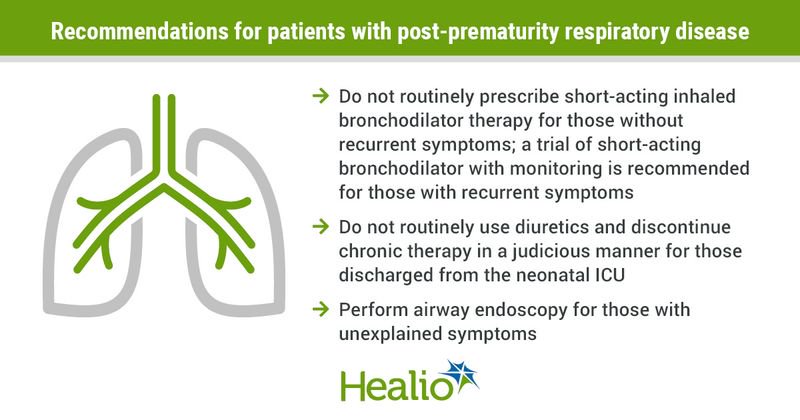New guidance addresses outpatient management of post-prematurity respiratory disease
Click Here to Manage Email Alerts
The American Thoracic Society published a new clinical practice guideline to aid physicians in the outpatient management of infants, children and adolescents with post-prematurity respiratory disease.
“There was a pressing need for updated guidance for clinicians who treat these patients,” ATS panel co-chairs A. Ioana Cristea, MD, MS, associate professor of clinical pediatrics in the division of neonatal-perinatal medicine at Riley Hospital for Children and Indiana University, Indianapolis, and Christopher D. Baker, MD, associate professor of pediatrics in the division of pediatric pulmonology and sleep medicine at the University of Colorado School of Medicine, Denver, said in a related press release. “These recommendations are intended to aid clinicians in the outpatient management of patients with post-prematurity respiratory disease, regardless of the degree of prematurity, the severity of disease or the age of the patient at the time of presentation.”

The multidisciplinary guideline panel included 26 experts in pediatric pulmonology, neonatology, sleep medicine, radiology and nursing as well as parents of children with post-prematurity respiratory disease. Using the Grading of Recommendations, Assessment, Development and Evaluation (GRADE) approach, the panel made recommendations for clinical practice on when and how to treat infants, children and adolescents with post-prematurity respiratory disease.
The recommendations, published in the American Journal of Respiratory and Critical Care Medicine, are conditional and based on very low-certainty evidence:
- Do not routinely prescribe short-acting inhaled bronchodilator therapy for those without recurrent respiratory symptoms, but a trial of short-acting bronchodilator with monitoring is recommended to assess clinical symptom improvement for those with recurrent respiratory symptoms.
- Do not routinely prescribe inhaled corticosteroids for those without chronic cough and recurrent wheezing, but a trial of inhaled corticosteroids with monitoring is recommended to assess clinical symptom improvement for those with chronic cough or recurrent wheezing.
- Do not routinely use diuretics for those with post-prematurity respiratory disease and discontinue chronic diuretic therapy in a judicious manner for those discharged from the neonatal ICU.
- Use polysomnography for those with persistent apnea, intermittent desaturation or bradycardia at greater than 40 weeks’ postmenstrual age who are ready for neonatal ICU discharge.
- Use polysomnography and/or sleep medicine referral for those with symptoms of sleep-disordered breathing such as persistent snoring, failure to thrive or persistent need for supplemental oxygen at age 2 years and obtain an overnight or 24-hour oximetry to screen for sleep-disordered breathing followed by polysomnography and/or sleep medicine referral when polysomnography is not available.
- Perform a swallow evaluation for those eating by mouth with cough or persistent oxygen desaturation during feeding; suspected or confirmed vocal cord paralysis or other anomalies; failure to wean from oxygen therapy or ventilatory support; persistent or worsening pulmonary hypertension; failure to thrive or chronic pulmonary symptoms out of proportion to viral respiratory infections.
- Perform airway endoscopy for those with unexplained symptoms, including chronic cough, wheezing, ventilator dependence, persistent hypoxemia or history of patent ductus arteriosus ligation.
- Do not use dynamic airway imaging to screen for routine tracheobronchomalacia for those without symptoms suggestive of airway malacia; use unsedated, dynamic airway imaging for diagnosing or reevaluating tracheobronchomalacia in those with recurrent symptoms suggesting airway malacia when anesthesia risk is higher than that from radiation or if bronchoscopy is not feasible or available.
“There are currently no medications or diagnostic testing that are universally indicated for those with post-prematurity respiratory disease,” the authors wrote. “However, future studies will elucidate which subgroups of patients will benefit from targeted therapies for the prevention and treatment of post-prematurity respiratory disease in a personalized approach.”
Reference:
- Outpatient management of patients with post-prematurity respiratory disease. Published Dec. 21, 2021. Accessed Dec. 22, 2021.
